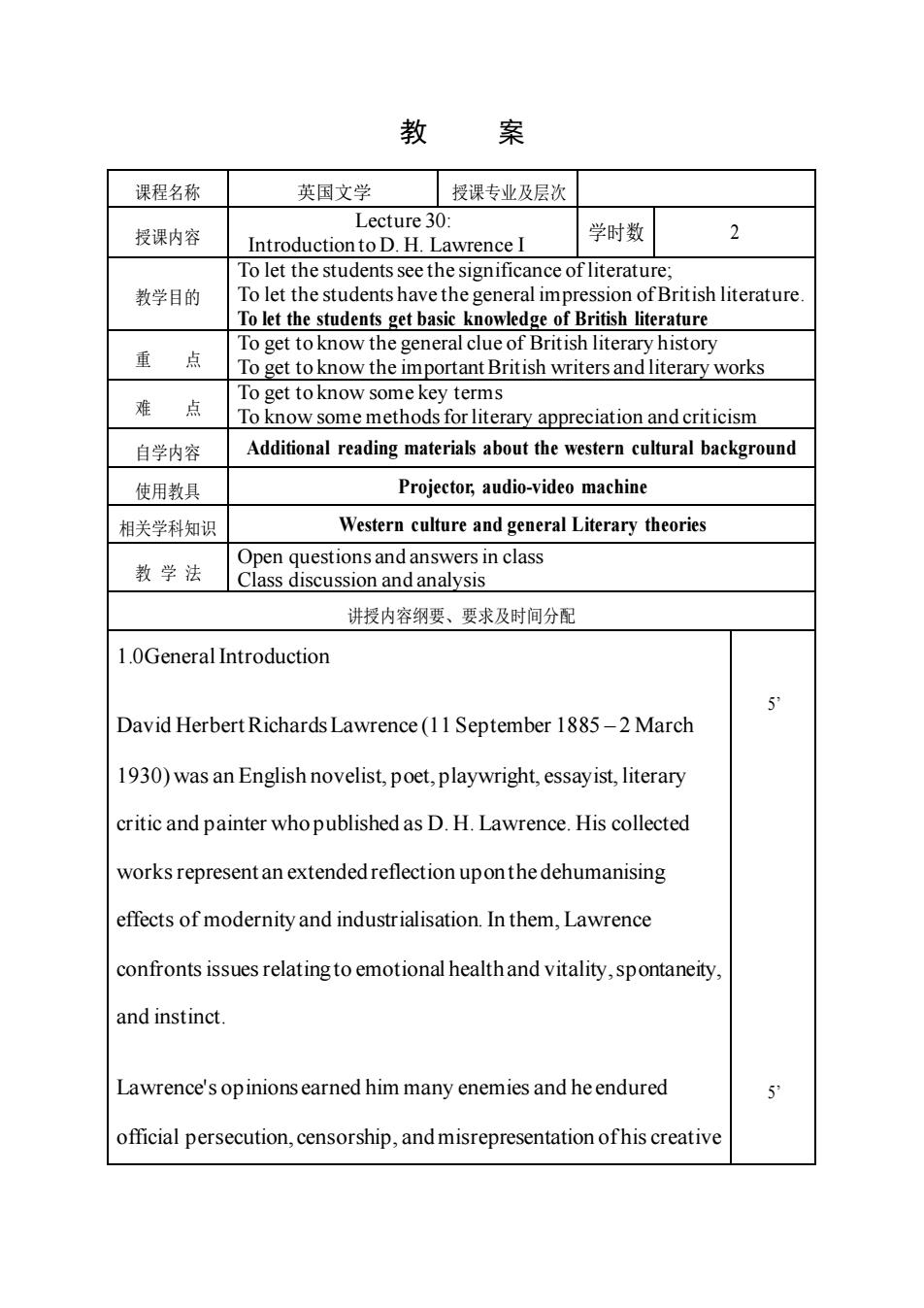
教 案 课程名称 英国文学 授课专业及层次 授课内容 Lecture 30: 学时数 2 Introductionto d h lawrence i To let the students see the significance ofliterature 教学目的 studentshave the generalimp ssion of British literature Toet the studentsget basic British iterature 重点 To get to know the general clue of British literary history To get to know the important British writers and literary works 难点 To get to know some key terms 自学内容 Additional reading materials about the western cultural background 使用教具 Projector,audio-video machine 相关学科知识 Western culture and general Literary theories Open questions and answers in class 教学法 Class discussion and analysis 讲授内容纲要、要求及时间分配 1.0General Introduction David Herbert Richards Lawrence(11 September 1885-2 March 1930)was an English novelist,poet,playwright,essayist,literary critic and painter who published as D.H.Lawrence.His collected works representan extendedreflection uponthe dehumanising effects of modernity and industrialisation.In them,Lawrence confronts issues relatingto emotional healthand vitality,spontaneity and instinct Lawrence's opinions earned him many enemies and he endured 5 official persecution,censorship,and misrepresentation ofhis creative
教 案 课程名称 英国文学 授课专业及层次 授课内容 Lecture 30: Introduction to D. H. Lawrence I 学时数 2 教学目的 To let the students see the significance of literature; To let the students have the general impression of British literature. To let the students get basic knowledge of British literature 重 点 To get to know the general clue of British literary history To get to know the important British writers and literary works 难 点 To get to know some key terms To know some methods for literary appreciation and criticism 自学内容 Additional reading materials about the western cultural background 使用教具 Projector, audio-video machine 相关学科知识 Western culture and general Literary theories 教 学 法 Open questions and answers in class Class discussion and analysis 讲授内容纲要、要求及时间分配 1.0General Introduction David Herbert Richards Lawrence (11 September 1885 – 2 March 1930) was an English novelist, poet, playwright, essayist, literary critic and painter who published as D. H. Lawrence. His collected works represent an extended reflection upon the dehumanising effects of modernity and industrialisation. In them, Lawrence confronts issues relating to emotional health and vitality, spontaneity, and instinct. Lawrence's opinions earned him many enemies and he endured official persecution, censorship, and misrepresentation of his creative 5’ 5’
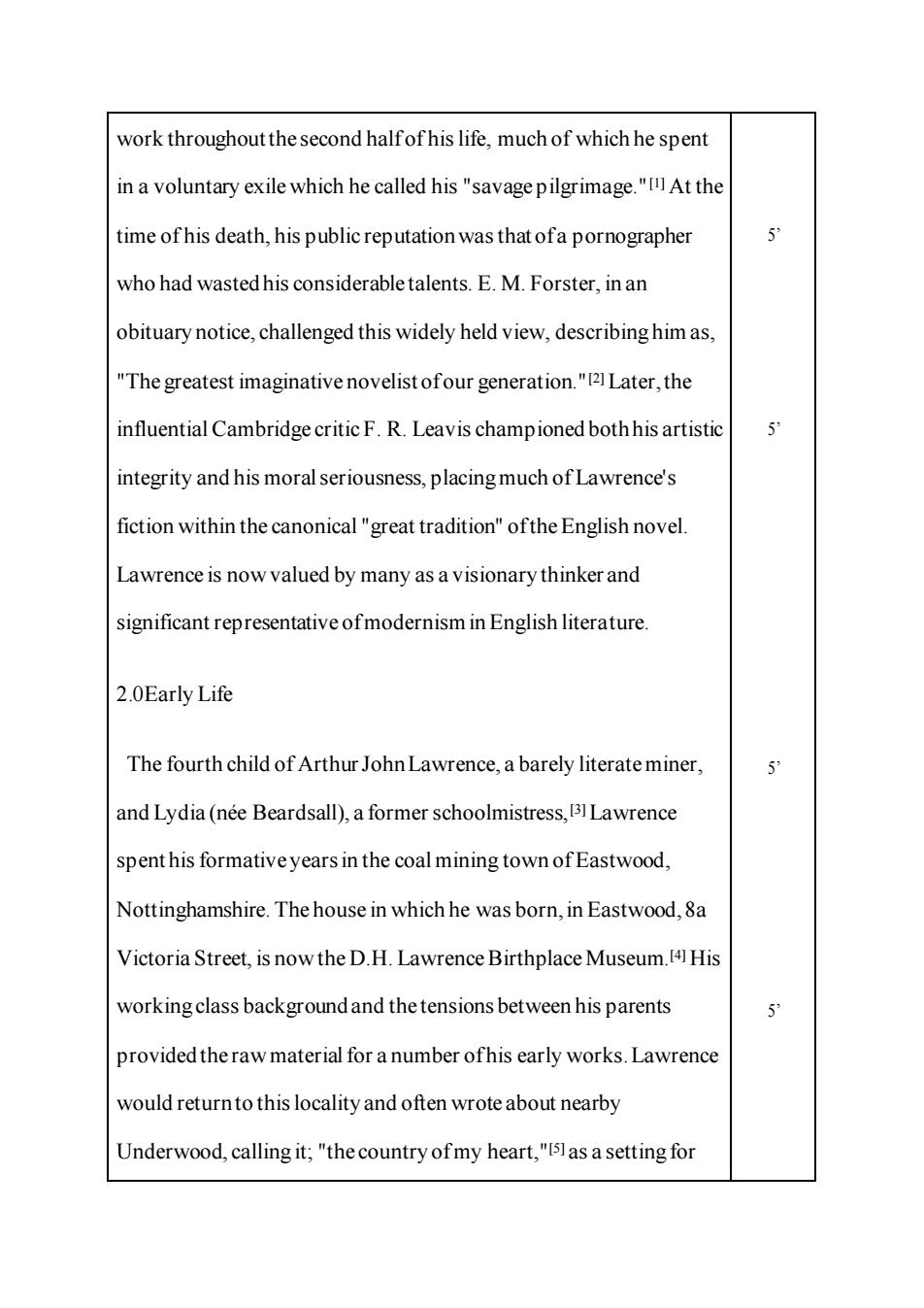
work throughout the second halfofhis life,much of which he spent in a voluntary exile which he called his"savage pilgrimage.At the time ofhis death,his public reputation was that ofa pornographer 5 who had wastedhis considerabletalents.E.M.Forster,inan obituary notice,challenged this widely held view,describing him as, "The greatest imaginative novelist ofour generation.Later,the influential Cambridge critic F.R.Leavis championed bothhis artistic 5 integrity and his moral seriousness,placingmuch of Lawrence's fiction within the canonical"great tradition"ofthe English novel Lawrence is now valued by many as a visionary thinker and significant representative ofmodernism in English literature. 2.0Early Life The fourth child of Arthur John Lawrence,a barely literate miner, 5 and Lydia(nee Beardsall),a former schoolmistress,Lawrence spent his formative years in the coal mining town of Eastwood. Nottinghamshire.The house in which he was born,in Eastwood,8a Victoria Street,is nowthe D.H.Lawrence Birthplace Museum.4 His working class background and the tensions between his parents 5 provided the raw material for a number ofhis early works.Lawrence would returnto this locality and often wrote about nearby Underwood,calling it,"thecountry ofmy heart,"I5 as a setting for
work throughout the second half of his life, much of which he spent in a voluntary exile which he called his "savage pilgrimage."[1] At the time of his death, his public reputation was that of a pornographer who had wasted his considerable talents. E. M. Forster, in an obituary notice, challenged this widely held view, describing him as, "The greatest imaginative novelist of our generation."[2] Later, the influential Cambridge critic F. R. Leavis championed both his artistic integrity and his moral seriousness, placing much of Lawrence's fiction within the canonical "great tradition" of the English novel. Lawrence is now valued by many as a visionary thinker and significant representative of modernism in English literature. 2.0Early Life The fourth child of Arthur John Lawrence, a barely literate miner, and Lydia (née Beardsall), a former schoolmistress,[3] Lawrence spent his formative years in the coal mining town of Eastwood, Nottinghamshire. The house in which he was born, in Eastwood, 8a Victoria Street, is now the D.H. Lawrence Birthplace Museum. [4] His working class background and the tensions between his parents provided the raw material for a number of his early works. Lawrence would return to this locality and often wrote about nearby Underwood, calling it; "the country of my heart,"[5] as a setting for 5’ 5’ 5’ 5’
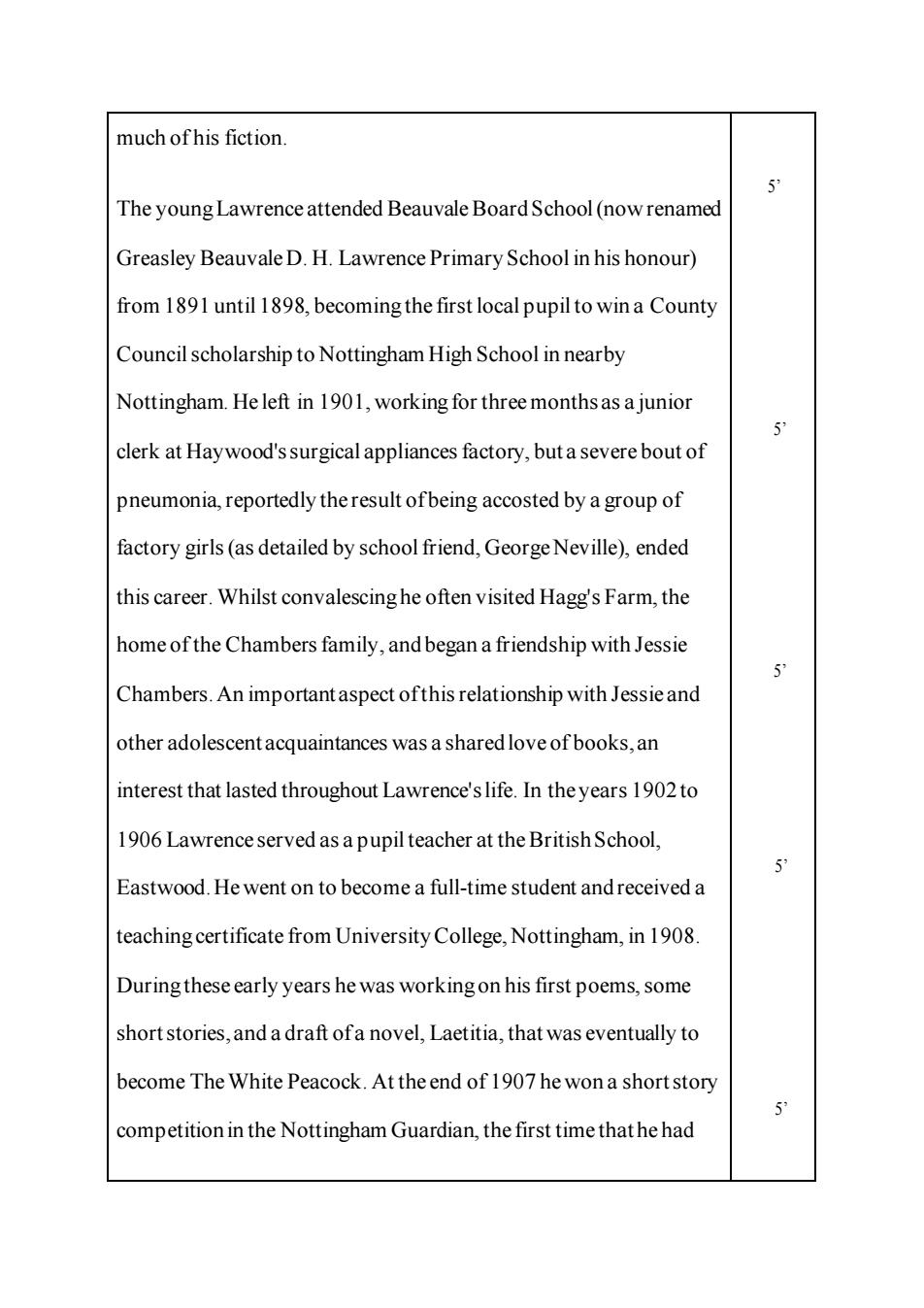
much ofhis fiction 5 The young Lawrence attended Beauvale Board School(now renamed Greasley Beauvale D.H.Lawrence Primary School in his honour) from 1891 until 1898,becoming the first local pupil to wina County Council scholarship to Nottingham High School in nearby Nottingham.He left in 1901,working for three months as a junior 5 clerk at Haywood'ssurgical appliances factory,but a severe bout of pneumonia,reportedly the result ofbeing accosted by a group of factory girls(as detailed by school friend,George Neville),ended this career.Whilst convalescinghe often visited Hagg's Farm,the home of the Chambers family,and began a friendship with Jessie Chambers.An importantaspect ofthis relationship with Jessieand other adolescentacquaintances was a shared love of books,an interest that lasted throughout Lawrence's life.In the years 1902to 1906 Lawrence served as a pupil teacher at the British School, 5 Eastwood.He went on to become a full-time student and received a teaching certificate from University College,Nottingham,in 1908. Duringthese early years he was workingon his first poems,some short stories,and a draft ofa novel,Laetitia,that was eventually to pecome The White Peacock.At theend of 1907 he wona shortstory 5 competition in the Nottingham Guardian,the first time that he had
much of his fiction. The young Lawrence attended Beauvale Board School (now renamed Greasley Beauvale D. H. Lawrence Primary School in his honour) from 1891 until 1898, becoming the first local pupil to win a County Councilscholarship to Nottingham High School in nearby Nottingham. He left in 1901, working for three months as a junior clerk at Haywood's surgical appliances factory, but a severe bout of pneumonia, reportedly the result of being accosted by a group of factory girls (as detailed by school friend, George Neville), ended this career. Whilst convalescing he often visited Hagg's Farm, the home of the Chambers family, and began a friendship with Jessie Chambers. An important aspect of this relationship with Jessie and other adolescent acquaintances was a shared love of books, an interest that lasted throughout Lawrence's life. In the years 1902 to 1906 Lawrence served as a pupil teacher at the British School, Eastwood. He went on to become a full-time student and received a teaching certificate from University College, Nottingham, in 1908. During these early years he was working on his first poems, some short stories, and a draft of a novel, Laetitia, that was eventually to become The White Peacock. At the end of 1907 he won a short story competition in the Nottingham Guardian, the first time that he had 5’ 5’ 5’ 5’ 5’
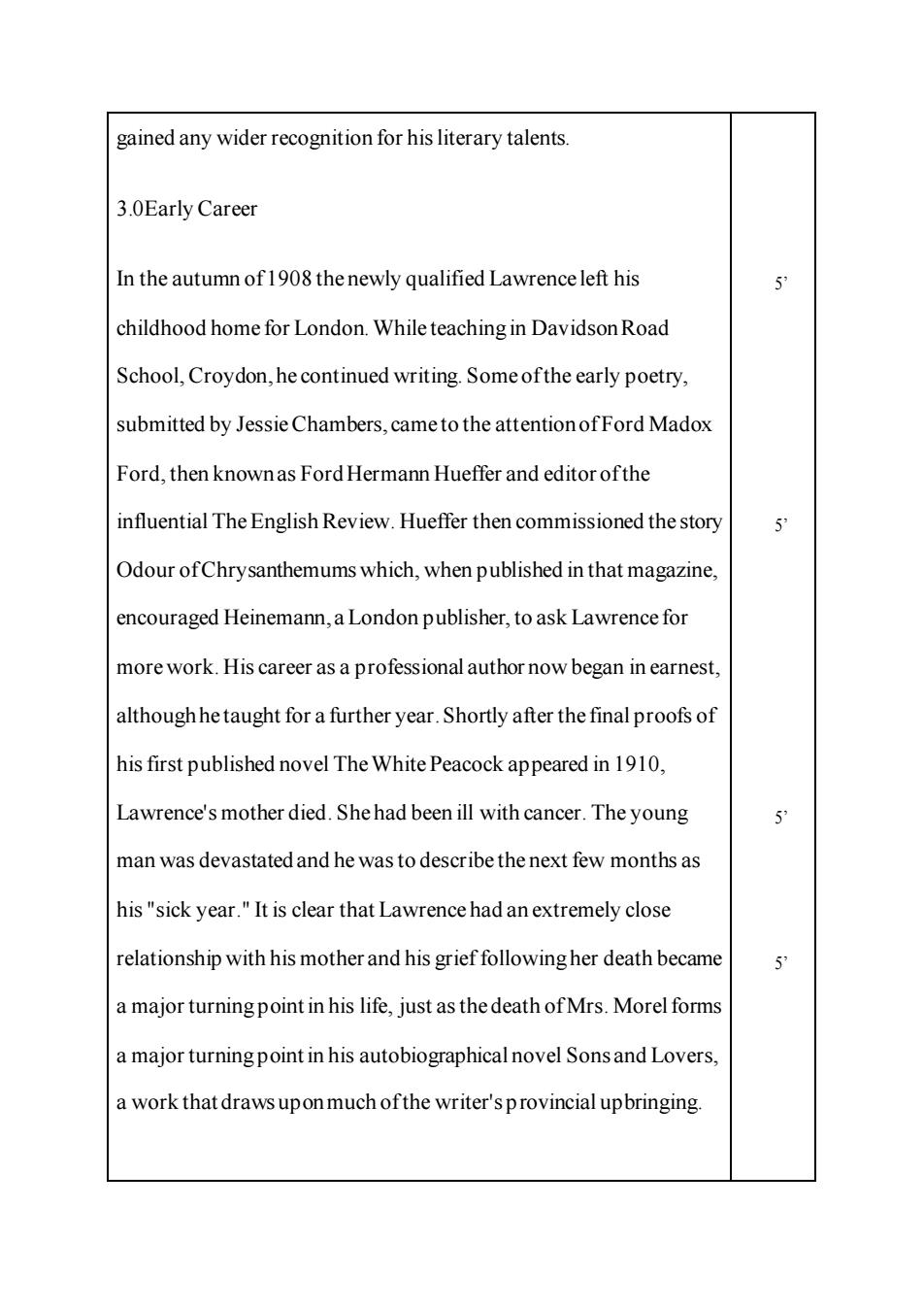
gained any wider recognition for his literary talents 3.0Early Career In the autumn of 1908 the newly qualified Lawrence left his 5 childhood home for London.While teaching in Davidson Road School,Croydon,he continued writing.Some ofthe early poetry, submitted by Jessie Chambers,came to the attentionofFord Madox Ford,then knownas Ford Hermann Hueffer and editor ofthe influential The English Review.Hueffer then commissioned the story Odour ofChrysanthemums which,when published in that magazine encouraged Heinemann,a London publisher,to ask Lawrence for more work.His career as a professional author now began in earnest although hetaught for a further year.Shortly after the final proofs of his first published novel The White Peacock appeared in 1910, Lawrence'smother died.Shehad beenill with cancer.Theyoung 5 man was devastated and he was to describe the next few months as his "sick year."It is clear that Lawrence had an extremely close relationship with his mother and his grief following her death became 5 a major turningpoint in his life,just as the death of Mrs.Morel forms a major turningpoint in his autobiographical novel Sons and Lovers. a work that draws uponmuch ofthe writer's provincial upbringing
gained any wider recognition for his literary talents. 3.0Early Career In the autumn of 1908 the newly qualified Lawrence left his childhood home for London. While teaching in Davidson Road School, Croydon, he continued writing. Some of the early poetry, submitted by Jessie Chambers, came to the attention of Ford Madox Ford, then known as Ford Hermann Hueffer and editor of the influential The English Review. Hueffer then commissioned the story Odour of Chrysanthemums which, when published in that magazine, encouraged Heinemann, a London publisher, to ask Lawrence for more work. His career as a professional author now began in earnest, although he taught for a further year. Shortly after the final proofs of his first published novel The White Peacock appeared in 1910, Lawrence's mother died. She had been ill with cancer. The young man was devastated and he was to describe the next few months as his "sick year." It is clear that Lawrence had an extremely close relationship with his mother and his grief following her death became a major turning point in his life, just as the death of Mrs. Morel forms a major turning point in his autobiographical novel Sons and Lovers, a work that draws upon much of the writer's provincial upbringing. 5’ 5’ 5’ 5’
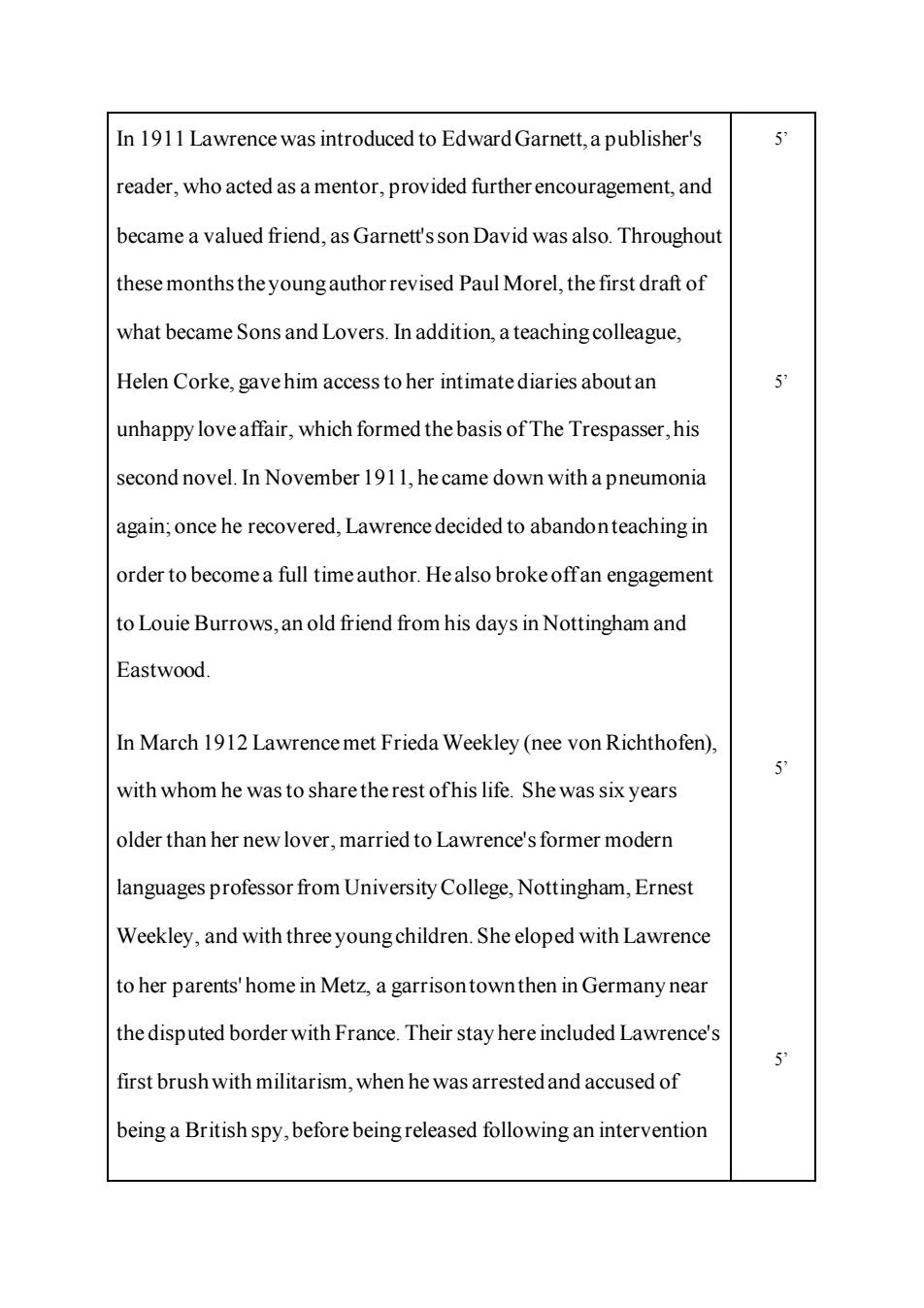
In 1911 Lawrence was introduced to Edward Garnett,a publisher's reader,who acted as a mentor,provided furtherencouragement,and became a valued friend,as Garnett's son David was also.Throughout these months the young author revised Paul Morel,the first draft of what became Sons and Lovers.In addition,a teaching colleague, Helen Corke,gave him access to her intimate diaries aboutan unhappy loveaffair,which formed the basis of The Trespasser,his second novel.In November 1911,he came down with a pneumonia again;once he recovered,Lawrence decided to abandonteaching in order to become a full time author.Healso broke offan engagement to Louie Burrows,an old friend from his days in Nottingham and Eastwood. In March 1912 Lawrence met Frieda Weekley(nee von Richthofen), 5 with whom he was to share therest ofhis life.She was six years older than her new lover,married to Lawrence's former modern languages professor from University College,Nottingham,Ernest Weekley,and with three youngchildren.She eloped with Lawrence to her parents'home in Metz,a garrisontown then in Germany near the disputed border with France.Their stay here included Lawrence's first brush with militarism,when he was arrested and accused of being a British spy,before beingreleased following an intervention
In 1911 Lawrence was introduced to Edward Garnett, a publisher's reader, who acted as a mentor, provided further encouragement, and became a valued friend, as Garnett's son David was also. Throughout these months the young author revised Paul Morel, the first draft of what became Sons and Lovers. In addition, a teaching colleague, Helen Corke, gave him access to her intimate diaries about an unhappy love affair, which formed the basis of The Trespasser,his second novel. In November 1911, he came down with a pneumonia again; once he recovered, Lawrence decided to abandon teaching in order to become a full time author. He also broke off an engagement to Louie Burrows, an old friend from his days in Nottingham and Eastwood. In March 1912 Lawrence met Frieda Weekley (nee von Richthofen), with whom he was to share the rest of his life. She was six years older than her new lover, married to Lawrence's former modern languages professor from University College, Nottingham, Ernest Weekley, and with three young children. She eloped with Lawrence to her parents' home in Metz, a garrison town then in Germany near the disputed border with France. Their stay here included Lawrence's first brush with militarism, when he was arrested and accused of being a British spy, before being released following an intervention 5’ 5’ 5’ 5’